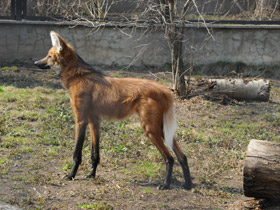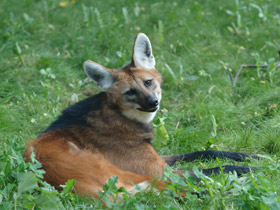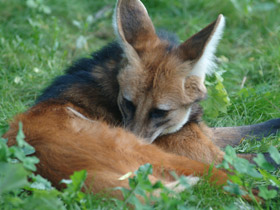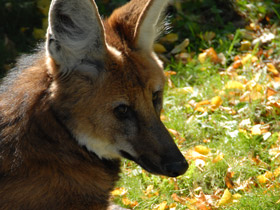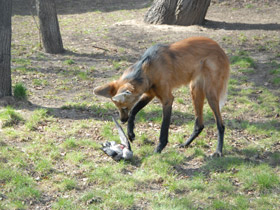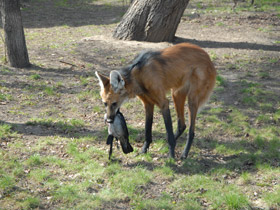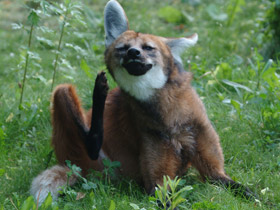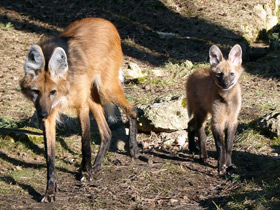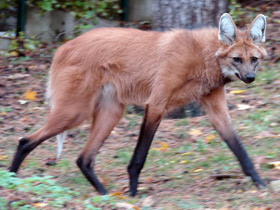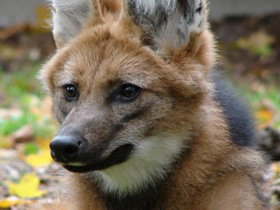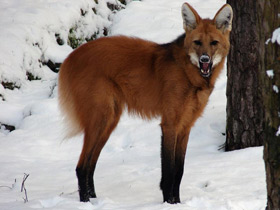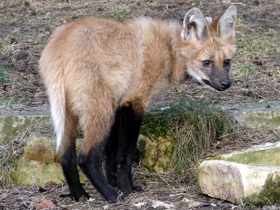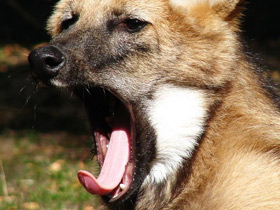The maned wolf (Chrysocyon brachyurus)
The maned wolf (Chrysocyon brachyurus) is a large canine of South America. It is found in Argentina, Brazil, Bolivia, Peru, and Paraguay, and is almost extinct in Uruguay. Its markings resemble those of foxes, but it is neither a fox nor a wolf. It is the only species in the genus Chrysocyon (meaning "golden dog").
This mammal lives in open and semi-open habitats, especially grasslands with scattered bushes and trees, in the Cerrado of south, central-west, and southeastern Brazil; Paraguay; northern Argentina; and Bolivia east and north of the Andes, and far southeastern Peru (Pampas del Heath only). It is very rare in Uruguay, possibly being displaced completely through loss of habitat. The International Union for Conservation of Nature lists it as near threatened, while it is considered a vulnerable species by the Brazilian Institute of Environment and Renewable Natural Resources. In 2011, a female maned wolf, run over by a truck, underwent stem cell treatment at the Zoo Brasília, this being the first recorded case of the use of stem cells to heal injuries in a wild animal.
Common name
- aguará guazú (from the Guaraní aguara "fox" guasu "big").
- borochi (in Bolivia).
- lobo de crin (in Peru).
- wolf of the marshes.
- wolf of the marshes.
- lobo colorado.
- lobo guará (in Brazil).
Etymology
The term maned wolf is an allusion to the mane of the nape. It is known locally as aguara guasu (meaning "large fox") in the Guarani language, or kalak in the Toba Qom language, lobo-guará in Portuguese, and lobo de crín, lobo de los esteros, or lobo colorado in Spanish. The term lobo, "wolf", originates from the Latin lupus. Guará and aguará originated from tupi-guarani agoa'rá, "by the fuzz". It also is called borochi in Bolivia.
Taxonomy
Although the maned wolf displays many fox-like characteristics, it is not closely related to foxes. It lacks the elliptical pupils found distinctively in foxes. The maned wolf's evolutionary relationship to the other members of the canid family makes it a unique animal.
Electrophoretic studies did not link Chrysocyon with any of the other living canids studied. One conclusion of this study is that the maned wolf is the only species among the large South American canids that survived the late Pleistocene extinction. Fossils of the maned wolf from the Holocene and the late Pleistocene have been excavated from the Brazilian Highlands.
A 2003 study on the brain anatomy of several canids placed the maned wolf together with the Falkland Islands wolf and with pseudo-foxes of the genus Pseudalopex. One study based on DNA evidence showed that the extinct genus Dusicyon, comprising the Falkland Islands wolf and its mainland relative, was the most closely related species to the maned wolf in historical times, and that about seven million years ago it shared a common ancestor with that genus. A 2015 study reported genetic signatures in maned wolves that are indicative of population expansion followed by contraction that took place during Pleistocene interglaciations about 24,000 years before present.
The maned wolf is not closely related to canids found outside South America. It is not a fox, wolf, coyote or jackal, but a distinct canid; though, based only on morphological similarities, it previously had been placed in the Canis and Vulpes genera. Its closest living relative is the bush dog (genus Speothos), and it has a more distant relationship to other South American canines (the short-eared dog, the crab-eating fox, and the zorros or Lycalopex).
Description
Chrysocyon brachyurus is a canid native to thicket regions.
Chrysocyon brachyurus has a remarkable appearance. In colour and build it looks more like a fox, and in Greek its name means "short-tailed golden dog". Of the dog breeds, it is of course the most similar to the greyhound, due to its unusually tall, slender legs and slender build. In fact, the Maned Wolfhound's body is rather short: 125-130 cm, and 74-87 cm in height at the withers, while at the same time it is very light and weighs only 20-23 kg.
The disproportion is further accentuated by the large ears and short tail, and the very long and narrow muzzle (photo 1-5, 12). The long legs of Chrysocyon brachyurus appear to be an evolutionary adaptation to its habitat, the grassy plains; they help the wolf to observe its surroundings and to detect prey from afar, easily making its way through tall grasses. Interestingly, Chrysocyon brachyurus pups are born with short noses. As they grow, they increase the length of a limb by growing a shin and metatarsal, as cheetahs do, but maned wolves, in contrast to them, are not good runners.
Habitat
The aguará guazú prefers grasslands and pastures in wetland and forest areas, occasionally found in jungle areas.
Distribution
It is distributed from the Paranaíba River in the Northeast region of Brazil, Argentine Mesopotamia south through the Chaco of Paraguay in Rio Grande del Sur (Brazil), the Paraná River basin, especially in the Bolivian Chaco and west of the Heath Pampas in Peru.
Distribution in Argentina
It had a distribution that reached the province of Mendoza as its southern and western limits, having disappeared in recent decades from much of its range due to hunting, destruction of aquatic environments and grasslands, and deforestation.
Distribution in Bolivia
In Bolivia it is found in almost all of its territory and is severely protected.
- Department of Santa Cruz: present in unexplored forests, cerrados, wetlands, particularly the Noel Kempff Mercado National Park.
- Department of Beni: found throughout the territory, populations are growing.
- Department of La Paz: found throughout the northern (Amazonian) zone, there are large populations in Madidi.
- Department of Pando: some populations are found in the south of the department in the area near the Beni and in the Manuripi-Heath.
- Department of Tarija: found throughout the area, but with isolated populations near Paraguay.
- Department of Cochabamba: it is found in the areas of the Cochabamba Amazon and valleys, there are growing populations in the Carrasco and Isíboro-Sécure parks, among others, where it is planted with awareness, it is not believed to be harmful to livestock.
- Department of Potosí: it is found in areas close to the departments of Cochabamba, Tarija, Chuquisaca.
- Department of Chuquisaca: found in the Bolivian Chaco.
Distribution in Paraguay
In Paraguay it is distributed in wetlands throughout its territory.
In the western region:
- Presidente Hayes Department: present throughout its entire length.
- Department of Alto Paraguay: present in the wetlands along the Paraguay River.
- Department of Boquerón: present in the wetlands and grasslands in the south of the department.
In the Eastern region:
- Departments of Concepción, Amambay and Canindeyú: present in the cerrados and wetlands of these departments.
- Departments of San Pedro, Caaguazú and Caazapá: these departments present local extinctions and decreasing populations.
- Departments of Itapuá and Alto Paraná: extinct in most of these departments.
- Departments of Cordillera, Central, Paraguarí, Ñeembucú and Misiones: declining populations in these departments.
- Department of Guairá: no information.
Distribution in Uruguay
In Uruguay it was considered extinct. However, in 1991 it was recorded in the department of Río Negro. During the 2000s there were several records: in the department of Rocha (2000, 2002), Cerro Largo (2006, 2007),7 and in Salto in 2021.
Nutrition
Chrysocyon brachyurus feeds almost equally on animal and vegetable food. It often hunts at dusk, almost always alone, mainly hunting small animals: rodents, rabbits, armadillos, birds and their eggs, various reptiles, as well as terrestrial molluscs and even insects. The weak jaws of Chrysocyon brachyurus do not allow it to tear or chew food, so it swallows it almost whole (photo 6, 7). This amazing beast is very fond of fruits and vegetables: bananas, guavas, roots and tubers of various plants.
Behaviour and peculiarities
In the wild, Chrysocyon brachyurus lives in pairs, but pairs rarely and rarely interact with each other. The pair practically never rests together and only occasionally takes joint walks (photo 8, 9).
Chrysocyon brachyurus are territorial animals, and neighbours rarely invade each other's plots, which they mark in the same way as domestic dogs (photo 10). In a zoo, each animal also has its own plot where it spends most of its time. In summer, Chrysocyon brachyurus is often seen wandering around its enclosure, oblivious to people approaching the net. This animal is rare throughout its range, which is why it is on the red list of the International Union for Conservation of Nature (IUCN).
Reproduction and lifecycle
Their mating season ranges from November to April. Gestation lasts 60 to 65 days, and a litter may have from two to six black-furred pups, each weighing roughly 450 g (16 oz). Pups are fully grown when one year old. During that first year, the pups rely on their parents for food.
Data on the maned wolf's estrus and reproductive cycle mainly come from captive animals, particularly about breeding endocrinology. Hormonal changes of maned wolves in the wild follow the same variation pattern of those in captivity. Females ovulate spontaneously, but some authors suggest that the presence of a male is important for estrus induction.
Captive animals in the Northern Hemisphere breed between October and February and in the Southern Hemisphere between August and October. This indicates that photoperiod plays an important role in maned wolf reproduction, mainly due to the production of semen. Generally, one estrus occurs per year. The amount of sperm produced by the maned wolf is lower compared to those of other canids.
Copulation occurs during the four-day estrus period, and is followed by up to 15 minutes of sexual intercourse. Courtship is similar to that of other canids, characterized by frequent approaches and anogenital investigation.
Gestation lasts 60 to 65 days and a litter may have from two to six pups. One litter of seven has been recorded. Birthing has been observed in May in the Canastra Mountains, but data from captive animals suggest that births are concentrated between June and September. The maned wolf reproduces with difficulty in the wild, with a high rate of infant mortality. Females can go up to two years without breeding. Breeding in captivity is even more difficult, especially in temperate parts of the Northern Hemisphere.
Pups are born weighing between 340 and 430 grams. They begin their lives with black fur, becoming red after 10 weeks. The eyes open at about 9 days of age. They are nursed up to 4 months. Afterwards, they are fed by their parents by regurgitation, starting on the third week of age and lasting up to 10 months. Three-month-old pups begin to accompany their mother while she forages. Males and females both engage in parental care, but it is primarily done by the females. Data on male parental care have been collected from captive animals, and little is known whether this occurs frequently in the wild. Maned wolves reach sexual maturity at 1 year of age, when they leave their birth territory.
The maned wolf's longevity in the wild is unknown, but estimates in captivity are between 12 and 15 years. A report was made of an individual at the São Paulo Zoo that lived to be 22 years old.
Relations with other species
The maned wolf participates in symbiotic relationships. It contributes to the propagation and dissemination of the plants on which it feeds, through excretion. Often, maned wolves defecate on the nests of leafcutter ants. The ants then use the dung to fertilize their fungus gardens, but they discard the seeds contained in the dung onto refuse piles just outside their nests. This process significantly increases the germination rate of the seeds.
Maned wolves suffer from ticks, mainly of the genus Amblyomma, and by flies such as Cochliomyia hominivorax usually on the ears. Interestingly, the maned wolf is poorly parasitized by fleas. The sharing of territory with domestic dogs results in a number of diseases, such as rabies virus, parvovirus, distemper virus, canine adenovirus, protozoan Toxoplasma gondii, bacterium Leptospira interrogans, and nematode Dirofilaria immitis. The maned wolf is particularly susceptible to potentially fatal infection by the giant kidney worm. Ingestion of the wolf apple could prevent maned wolves from contracting this nematode, but such a hypothesis has been questioned by several authors.
Its predators are mainly large cats, such as the puma (Puma concolor) and the jaguar (Panthera onca), but it is most often preyed upon by the jaguar.









